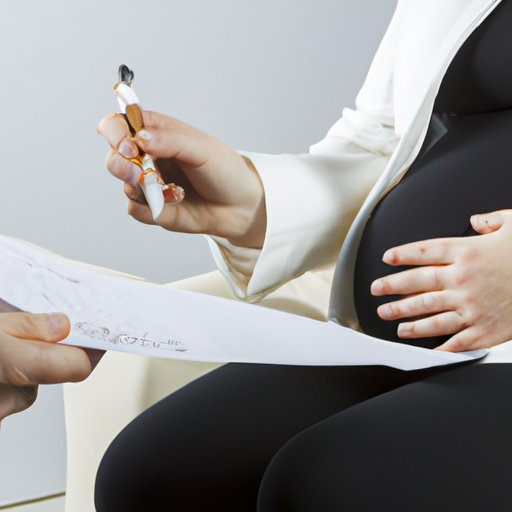
Introduction
When you’re pregnant, knowing if your water broke is crucial as it means that labor is on its way. But how can you tell if it’s your water breaking or just a normal pregnancy discharge? In this article, we’ll go through the signs and symptoms of water breaking, how to differentiate between discharge and amniotic fluid, home testing methods, timing contractions, talking to your doctor about it, and preparing for labor and delivery.
Signs to Look for
The most common sign of water breaking is the sudden gush of fluid from the vagina. However, not all women experience this, and there are other symptoms to look out for, including:
- Feeling a sudden pop or gush as if you have wet yourself
- A constant trickle of water down your legs
- Fluid that smells different than urine
- Cloudy or bloody amniotic fluid
- Feeling something like a pad or cushion between your legs, which might be the baby’s head
It’s important to note that not all women experience the same symptoms, and some may not experience any symptoms at all.
Discharge or Amniotic Fluid
As a pregnant woman, you’ll experience vaginal discharge throughout the pregnancy. Discharge is usually odorless, sticky, and white or clear in color. However, if you suspect that your water has broken, it’s essential to learn how to differentiate between normal discharge and amniotic fluid.
Amniotic fluid is usually clear or slightly yellow in color. The fluid usually has no odor or a slightly sweet smell. It’s generally thin and watery and can be mistaken for urine.
On the other hand, normal pregnancy discharge is usually thicker and stickier than amniotic fluid. Normal discharge can range in color from clear to white and can be yellowish or greenish at times. It’s usually odorless and doesn’t cause any itching or burning sensation.
Home Testing
If you’re unsure if your water broke or not, you can do a simple home test to check the presence of amniotic fluid. Here’s how to do a self-check at home:
- Clean your vaginal area thoroughly
- Place a sanitary pad on your underwear and wait for at least 30 minutes
- Remove the pad and observe the color and texture of the fluid that’s collected. If it’s amniotic fluid, it will be clear or slightly yellow and will have a sweet smell. On the other hand, if it’s normal discharge, it will be thicker and stickier and may have a white or yellow color.
However, it’s important to note that home testing doesn’t confirm if your water has broken or not, and the only way to know for sure is to consult a doctor.
Timing Contractions
Timing contractions can help you determine whether your water broke or not. If your water broke, you’ll experience regular contractions, which help to dilate the cervix and prepare your body for labor and delivery. Here are a few things to consider when timing contractions:
- Braxton Hicks contractions are not real contractions, but are instead a warm-up for the muscles. They are usually sporadic and don’t follow any pattern. True labor contractions, on the other hand, follow a regular pattern and become more frequent and intense over time.
- It’s essential to time the duration and frequency of your contractions from the onset of one contraction to the onset of another contraction. You can use a timer, pen, and paper, or use an app to help you time them.
Consult a Doctor
If you’re unsure if your water has broken, it’s important to consult a doctor. Your doctor will perform a pelvic exam and may conduct additional tests to confirm or rule out the rupture of the membranes. In addition, if your water has indeed broken, your doctor will monitor you and your baby closely to avoid any potential risks, including infection.
When talking to your doctor, it’s essential to discuss any symptoms you’ve been experiencing and any concerns you may have. Your doctor will be able to give you the best advice based on your individual situation.
Preparing for Labor
Once you know that your water has broken, it’s essential to prepare for labor and delivery. Here are a few things to keep in mind:
- Stay calm and relaxed as much as possible
- Stay hydrated and eat well to keep your energy levels up
- Remember to breathe through contractions and try to stay focused on the end goal: meeting your baby
- Have a bag packed with all the essentials you may need during your hospital stay
Conclusion
Knowing if your water broke is essential for pregnant women. While sudden gushes of fluid are a clear indicator, not all women experience this. In addition, it’s easy to mistake normal pregnancy discharge for amniotic fluid. This article has covered some signs to look for, home testing methods, timing contractions, and preparing for labor and delivery, but it’s essential to consult a doctor if you’re unsure if your water has broken. Remember, staying calm and focused can help you manage labor and delivery with ease.





